How to plan an epic Olympic Peninsula road trip
A Pacific Northwest local shares all you need to plan an epic Olympic Peninsula road trip: beaches, lakes, old-growth, mossy trees, alpine views, and more—an excellent resource for first-time visitors.
Includes nine TikTok videos!
This article about planning an Olympic Peninsula road trip is for you if:
- You’re visiting the Olympic Peninsula with limited time.
- You want to explore Olympic National Park but need help figuring out where to begin.
- You seek reliable local knowledge for travel in Washington State.
- You’re attending my nature immersion retreat and want to add time before/after the experience.
Best for first-time visitors or those with limited time (less than four days) on the Olympic Peninsula.
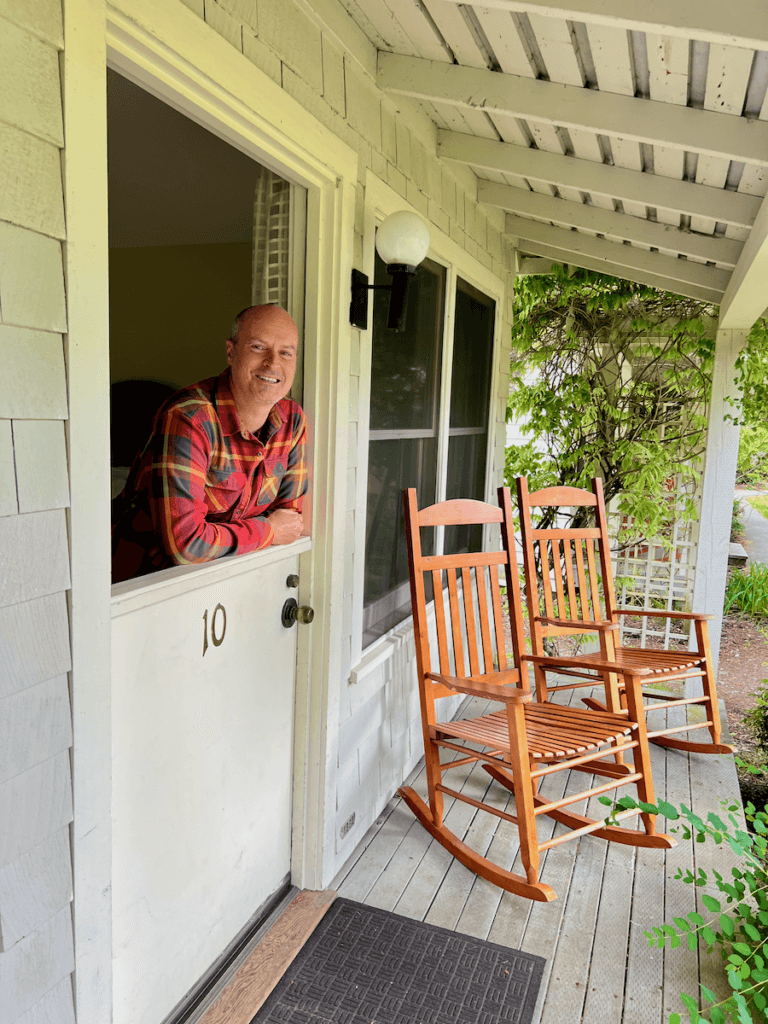
How to plan an epic Olympic Peninsula road trip
Look for my nine TikTok videos with stories about the Olympic Peninsula and area throughout this article.
- Why should you listen to me?
- Let me help you plan an epic PNW trip.
- General planning tips
- Why nature-forward matters
- Forest Bathing on the Olympic Peninsula
- Important activities to plan
- Dramatic coastlines & beaches
- Pristine glacial lakes
- Old-growth rainforests & mossy goodness
- Olympic Peninsula Alpine views
- Where to stay on the Olympic Peninsula
- Where to eat on the Olympic Peninsula
- Olympic Peninsula road trip itineraries
- Nature immersion retreat: adding time before or after
- Other National Parks in Washington State
- How to travel to/from the Olympic Peninsula
Why should you listen to Matthew Kessi (that’s me)?
- The Pacific Northwest is my lifelong playground.
- As a former travel industry professional, my experience guiding people around Oregon and Washington State gives me valuable insight into the right balance between what is possible and rewarding.
- Unlike big travel websites, I’ve been to all the places, tested the ideas, eaten the food, and taken photos. Unless specified, I don’t receive compensation for naming specific locations — my recommendations come from the heart.
- Since I live in Seattle, I visit the Olympic Peninsula frequently to keep my knowledge updated.
- I’m a practical mystic, which means I actively integrate spiritual sensitivities and meaningful applications in daily life. I can help you find more rewarding experiences grounded in nature — and you can be more present to yourself, your companions, and all the wonders of travel. Check out the growing Kessiworld YouTube channel with magical nature videos designed to help you practice a powerful Nature Connection (more info below.)
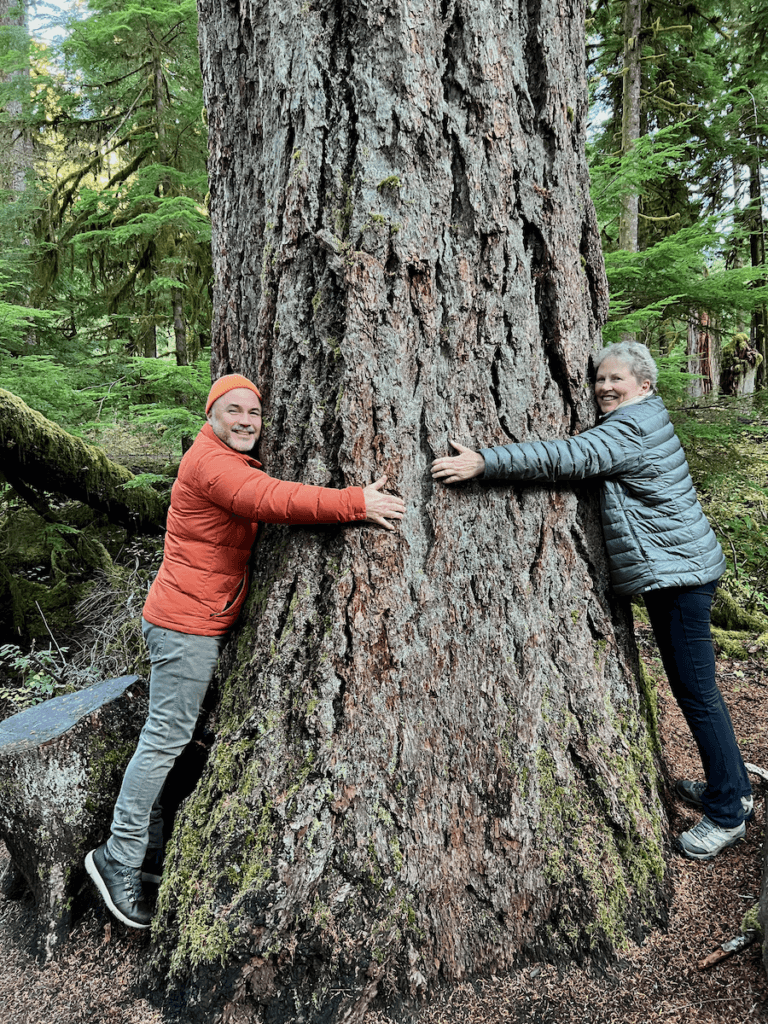
Experience a 20-minute Olympic Peninsula Nature Connection.
Quiet your mind, open your heart, and allow your intuition to flow by following my guided Nature Connection Experiences, several filmed in the Olympic National Park (Click the link to the specific videos below.)
A 20-minute guided Nature Connection video can help you deepen your mindfulness of the natural world in ways that will bring healing, wellness, and awakening.
Not quite meditation, not quite contemplation, and a lot of work with Nature’s Intelligence, this experience helps wake up your inner self in ways that might surprise you.
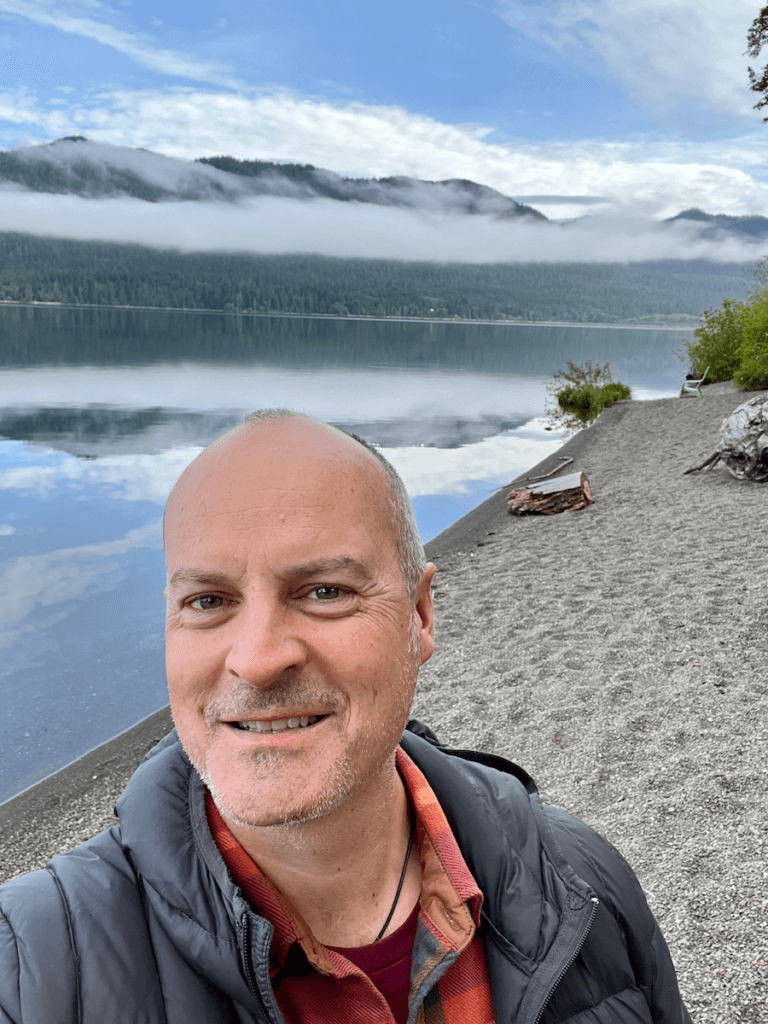
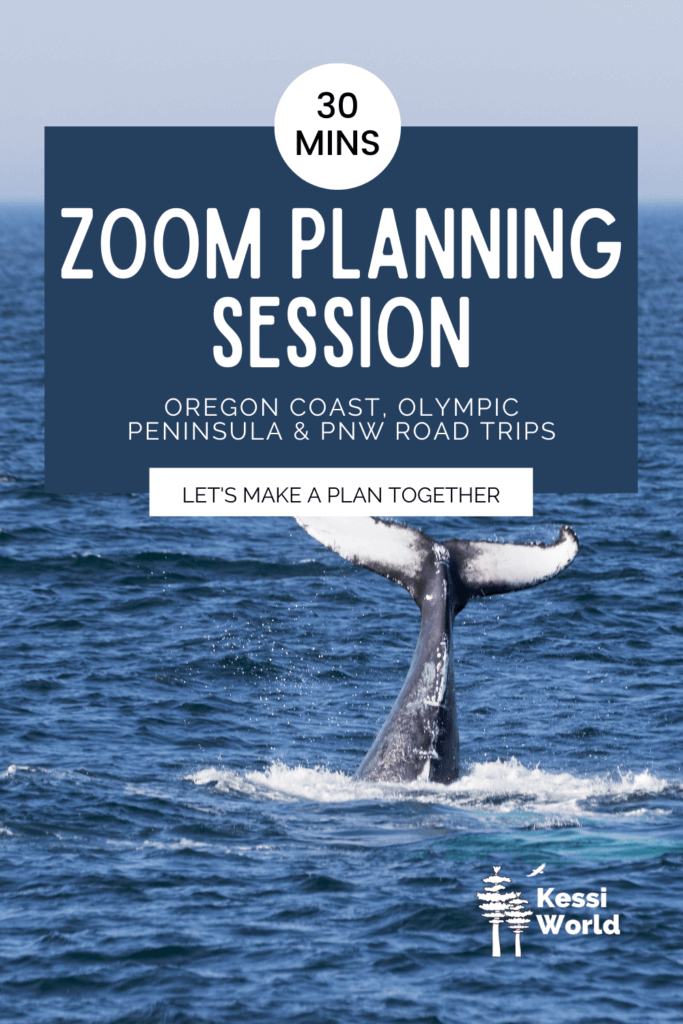
Let me help you plan an epic trip to the Olympic Peninsula or Pacific Northwest.
If you’re new to Washington State or interested in detailed nature-forward options — let me help you plan an epic Olympic Peninsula road trip. I offer Zoom meetings where our conversation leads to two potential itineraries for an exciting and thoughtful journey. Or, I will provide honest feedback about your planning work-in-progress. Click here for more information.
How much time should you allow when planning an Olympic Peninsula road trip?
The Olympic Peninsula has one main road, Highway 101, that circles the entire area. The whole loop is 300 miles and takes about 6 hours. But why would you want to drive nonstop?
The best time to explore the Olympic Peninsula is as long as possible. A long weekend (three-day) provides a great starter into the lush beauty of this wild part of Washington State. Keep in mind time seems to warp in this part of the world. What seems straightforward on paper becomes more time needed to enjoy the setting.
A day trip from Seattle to the Olympic Peninsula is possible, albeit a long day of driving. You’ll be best to visit the northern parts of Olympic National Park and concentrate on Lake Crescent and Hurricane Ridge. This itinerary takes about 8 hours (just driving) and covers about 250 miles.
When to go to the Olympic Peninsula.
Much like most of the Pacific Northwest, the summer season provides the best weather conditions to enjoy a road trip. Visitors bustle this time of year, making services more expensive and harder to book. To enjoy busier attractions like Hurricane Ridge or Hoh Valley Rainforest, you must go early or late — but avoid midday hours.
I enjoy the shoulder seasons of the year, like September, October, April, and May, because the weather usually holds up, there is still ample daylight to explore, and the summer crowds diminish.
November is a great time to go leaf peeping, as the lower elevations don’t really “turn” until the end of October and into November. But… bring rain gear!
The winter is magical on the Olympic Peninsula, albeit cold, wet, and dark. This can be a great time of year to watch storms roll in from the ocean (safely, please) and take soulful hikes on trails all but abandoned. Lodging is easier to book at better prices as well. When visiting November through March, Lake Quinault Lodge is outstanding — cozy up to the roaring fire steps away from a magnificent rainforest.
What to wear on an Olympic Peninsula road trip.
The Olympic Peninsula is a temperate rainforest famous for wet weather any time of year, so always have a solid waterproof outer shell on hand. If hiking is planned, be prepared with waterproof footwear. Take layers, especially because early mornings, any time of year, can be chilly, opening up to warmer afternoons and evenings. Once the sun sets, the usual is back to hoodie conditions.
The area, particularly Lake Quinault, seems to have a colder micro-climate, so between October and April, be sure to have winter clothing (gloves, boots, and hats) on hand, just in case. The Pacific Northwest doesn’t present apparent heat and beach-like conditions, but the sun still has power, especially in the summer around the lake. Be mindful of the rays, wear sunscreen, and take plenty of water if planning longer hikes.
Entrance fees to Olympic National Park.
As for fees, the Olympic National Park is $30 per car pass, valid for seven days. The Olympic Annual Pass (valid for Olympic National Park for 12 months) is $55; for America, the Beautiful, for all National Parks, the annual pass is $80. It’s easy to purchase upon arrival, but other options, including the complete fee structure, are on the NPS website. Remember that there are no park fees around Lake Quinault, but places like Hoh Rain Forest and Hurricane Ridge require entrance fees.
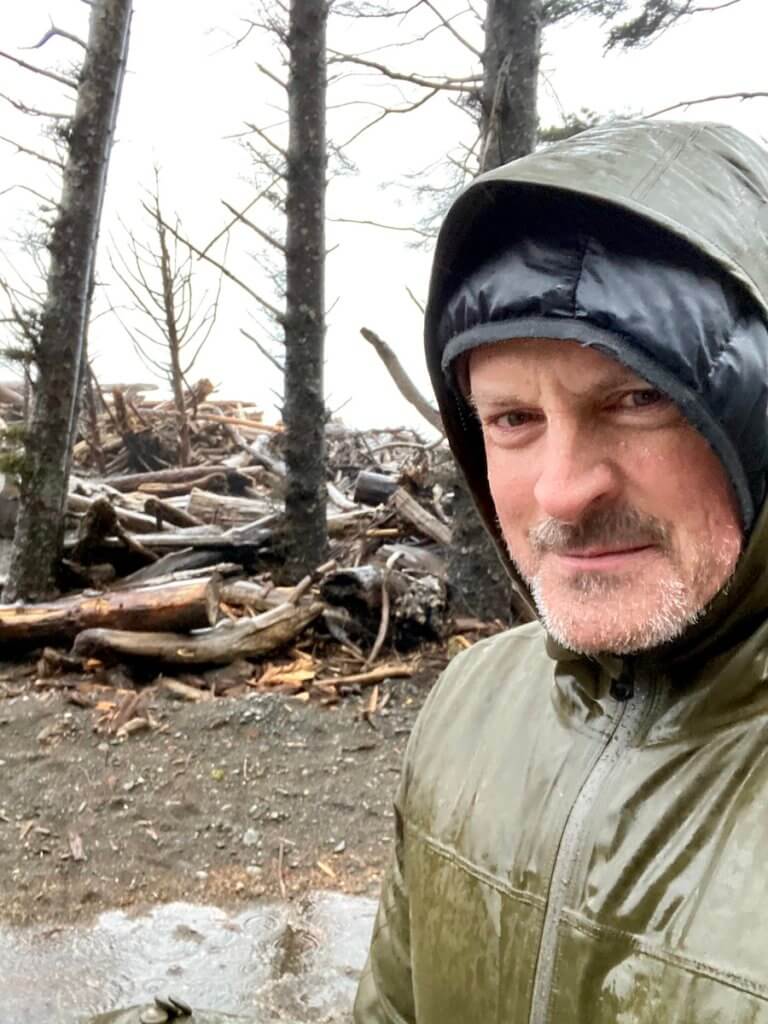
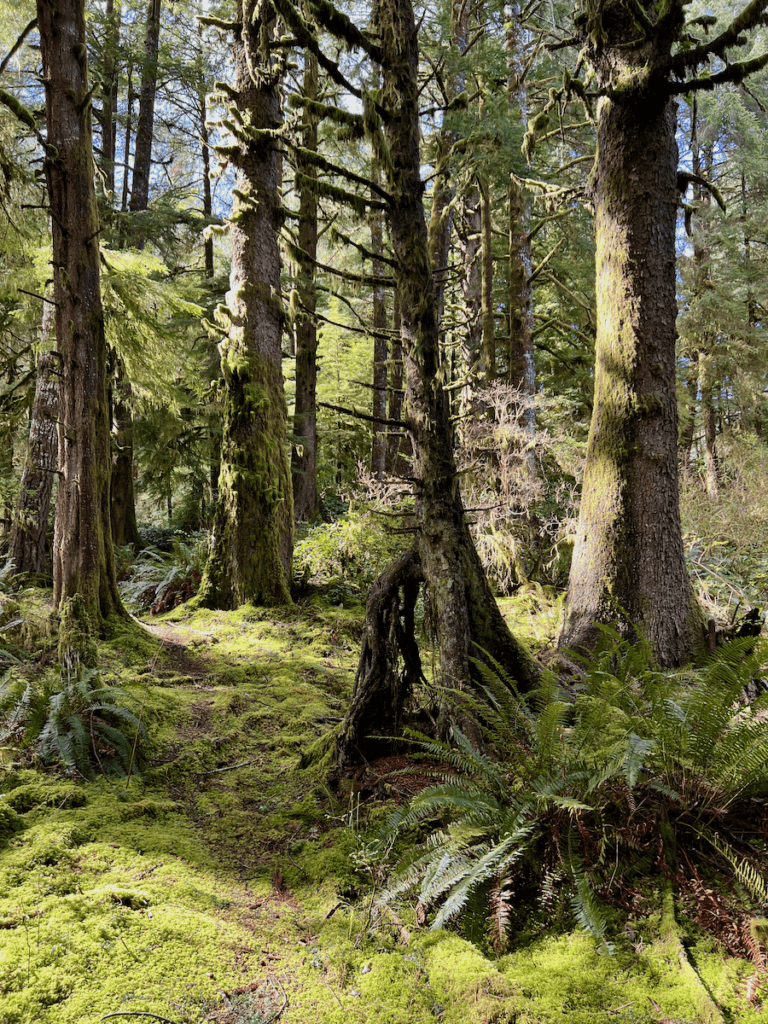
Why nature-forward matters.
The difference between an “eh” experience and a memorable one is about grounding with the natural environment. You can probably think back to wonderful travel experiences, and the common denominator would be feelings of belonging — or connection — to yourself, your companions, and the destination.
Whether that is a fun conversation with a server at a quirky restaurant or sighting a rare bird landing on your veranda, the magic occurs when you’re open to the beauty of a connection. It’s the wonder that awakens in your heart and soul.
And often, the loudness of modern culture, especially on vacation in an unfamiliar place, adds static. The static prevents a total opening up to the possibilities, consciously or subconsciously. That’s why — without grounding — you might return home feeling like you need a vacation from your vacation.
Nature-forward focuses on the “loudness of the ocean” — making your connection to the land the priority of travel. But don’t worry. You can still enjoy your favorite experiences, like witnessing droplets falling from a mossy branch, dodging drift logs on an expansive beach, or canoeing in a glacial lake. Overlaying a nature-forward focus makes all these things more meaningful because you’re more connected to heart and soul — or intuition.
Over my lifetime, I’ve developed six steps guaranteed to help anyone practice a nature-forward connection. Staying grounded and mindful takes as little as 30 minutes daily. I give you all the information in this article, How to transform your travel experience with nature-forward vacations.
My information, including the itineraries, incorporates mindfulness in nature into the mix. While practicing a nature-forward focus in these soul-nourishing locations doesn’t take longer, it will transform how you see the Olympic Peninsula, Washington State, and travel.
Forest Bathing on the Olympic Peninsula?
Forest bathing, or Shinrin Yoku, is a concept that originated in Japan in the 1980s as its population migrated from rural to urban living to support a booming economy based on manufacturing and technology. However, in this transition, companies found that their employees were prone to sickness and burnout.
Japan’s government commissioned studies to get to the root problem. They found empirical proof that a mindful re-connection to the Natural World worked well as a remedy against the stress of daily life in a demanding corporate environment.
The concept of “forest bathing” comes from the phytoncides and other essential oils emitted from forest trees. They quite literally rain down. Several studies have shown that the fragrance of phytoncides reduces stress and promotes immunocyte growth, including natural killer (NK) cells.
Furthermore, a growing body of research points to the beneficial effects of exposure to the Natural World on health, reducing stress, and promoting healing. Some studies further clarify that only 20 minutes daily (of immersive Natural experiences) are essential to producing lasting benefits such as lower blood pressure, higher concentration, improved mental health, regulating cortisol levels, neutralizing inflammation, and even higher sexual satisfaction.
If you’re interested in more information, I’ve written a step-by-step guide, “Forest Bathing for Beginners” that offers simple and proven ways to find more meaning and fulfillment in a deeper Nature Connection.
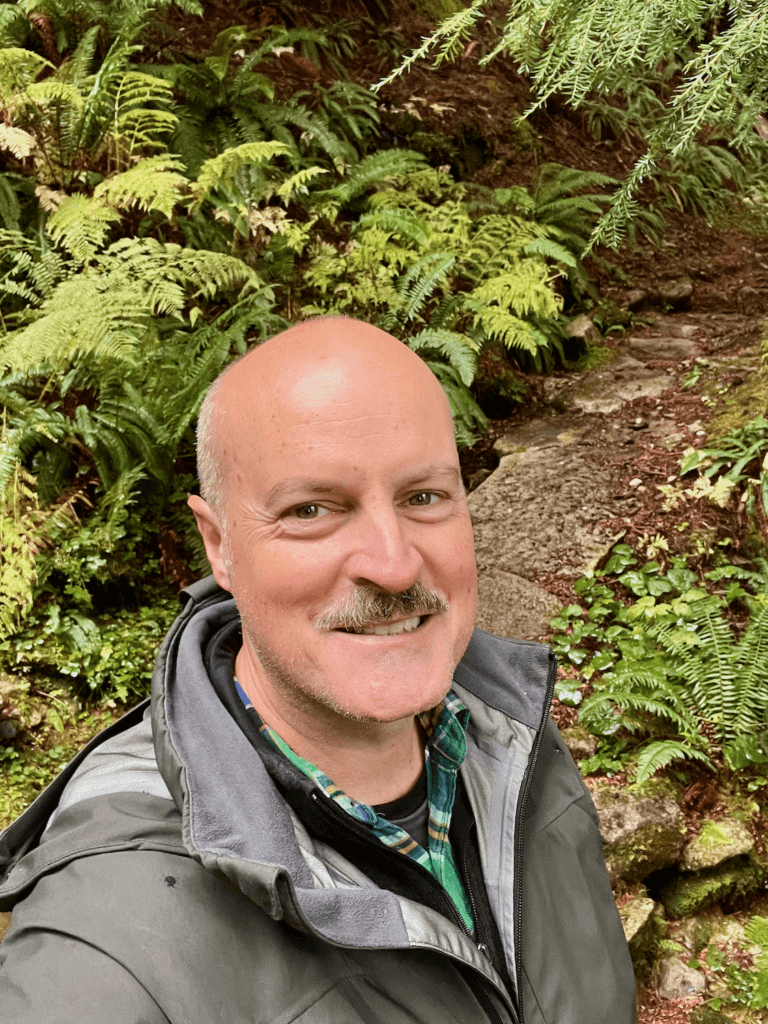
Where can you go Forest Bathing on the Olympic Peninsula?
The answer is anywhere! If you want some pointers, check out my article, “Forest Bathing Near Me — a guide to finding the best places to connect with Nature.”
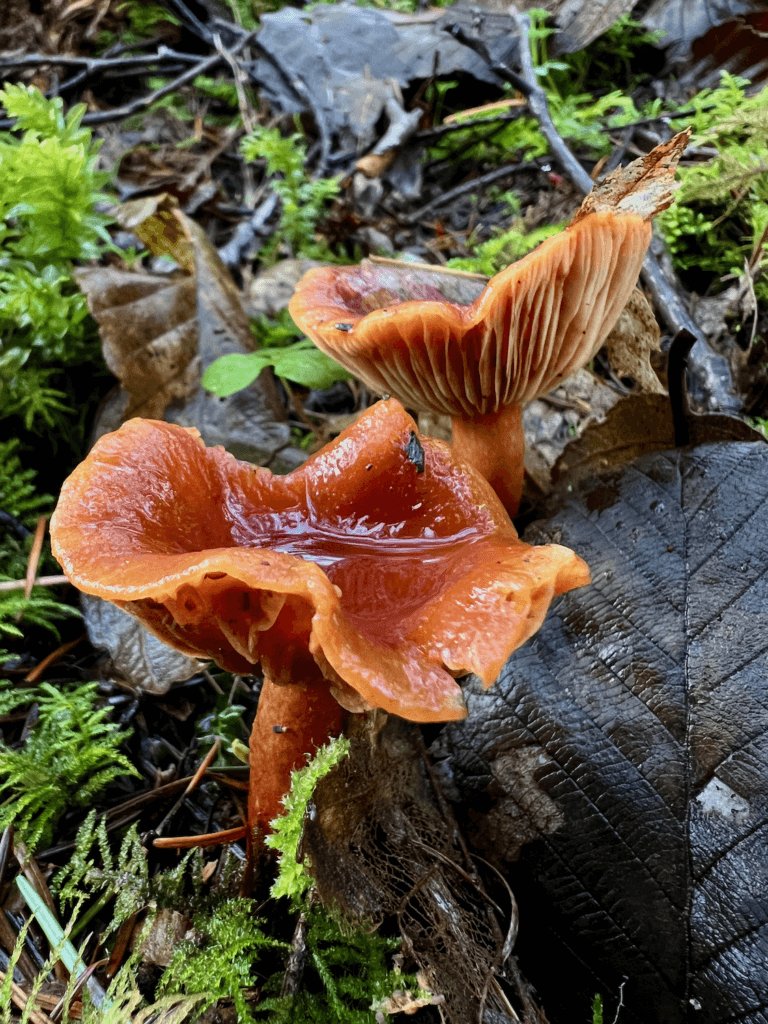
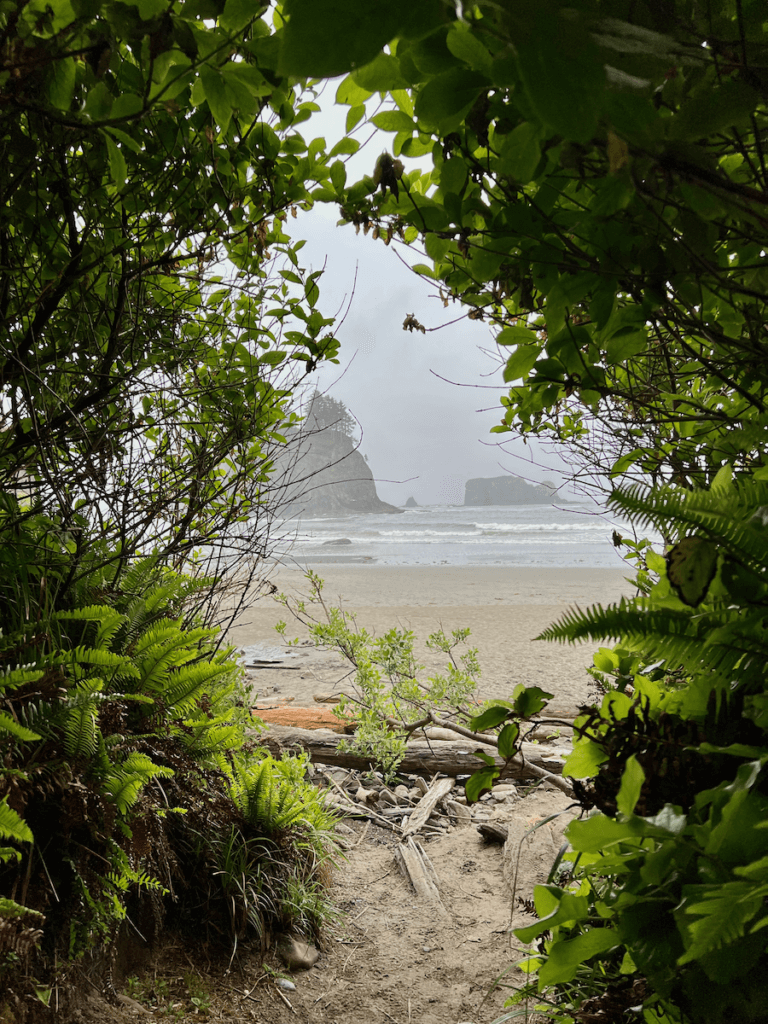
What things should you plan on an Olympic Peninsula road trip?
Look at this journey as a collection of different experiences instead of a passport stamp of places. Sure, there are top 10 lists all over the internet, but I strongly recommend your trade out quantity for quality. This means incorporating more experiences into each stop — and taking fewer stops.
What do I mean? Take Hoh Valley Rainforest, for example. It is an hour roundtrip from the main Highway and often has a backup at the entrance to the Olympic National Park during peak times (summer and weekends). Suppose you’re looking for a photo opp and wish to avoid hiking for a few hours in the lush wilderness. In that case, it’s better to use your time to visit Lake Crescent — where you can enjoy the lake and then hike to Marymere Falls among old-growth giants also nestled in moss.
If you’re short on time — anything less than four days — consider choosing one thing in each category of nature to use as your anchor and allow spontaneity to work with filling in your time.
What are the anchor experiences on an Olympic Peninsula road trip?
For shorter trips, there are five main nature experiences to enjoy. Select one thing in each category to use as your anchor. Then, allow spontaneity, such as a soulful hike through luscious scenery.
- Dramatic coastlines and beaches
- Pristine glacial lakes
- Old-growth forest
- Mossy rainforest delight
- Alpine views
Dramatic coastlines and beaches
This part of Washington State is wild, and between the Pacific Ocean and the Strait of Juan de Fuca, fascinating marine experiences abound. Here are my recommendations for an Olympic Peninsula road trip.
Second Beach
My favorite of the group is Second Beach, mainly for the magical 1.6-mile roundtrip hike through a hobbit-esque forest. Soak your soul in the mossy goodness and breathe the dense rainforest air as the sounds of the surf increase. Then, pass a thicket-turned-portal and arrive at an impressive collection of rock stacks framed by massive drift logs and the beating of frothy waves glazing across a sandy beach.
The parking area is on the way to LaPush, WA. You must commit at least four hours to this experience for full effect (to/from Forks, WA). If this is too much time, consider the following suggestions.
Rialto Beach
This is a popular beach destination because of the easy access from the parking lot to the wild Pacific Ocean coastline. The beach walk to Hole-in-the-wall is also exciting. Best if you need accessibility. Similar to what I mentioned for Second Beach, if driving the loop, skip it if you’re coming for a photo op — and go to Ruby Beach (discussed below).
Salt Creek Recreational Area
If you’re coming from Seattle and only have a little time (like a day trip), visit the Salt Creek Recreational Area. It’s near Port Angeles and saves much time from driving the additional hour out and back to Rialto or Second Beaches.
Ruby Beach
In addition, if you’re driving the complete Olympic Peninsula Loop, stop at one or two of the Kalaloch Beaches or Ruby Beach (my favorite). They are conveniently along Highway 101 and provide similar views, albeit less dramatic rock stacks, compared with Second or Rialto Beaches.
Cape Flattery
Cape Flattery and Neah Bay, hosted by the Makah People, is a fascinating place to visit. It does require a more significant time commitment. It’s two hours each way from Lake Crescent or adds about two hours to an itinerary driving the Olympic Peninsula Loop (without time to hike).
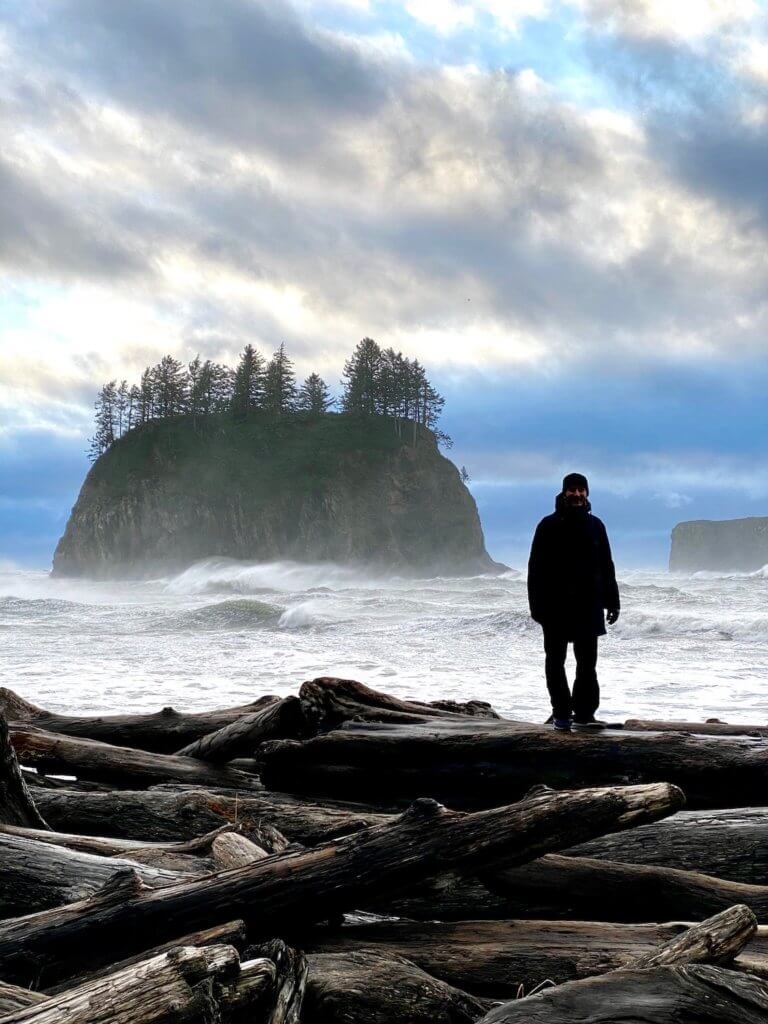
What about seeing pristine glacial lakes on the Olympic Peninsula?
The two famous glacial lakes on the Olympic Peninsula rest on opposite ends of the Olympic National Park. Lake Crescent hails to the north, about 20 minutes from Port Angeles, WA, while Lake Quinault sits to the Southwest in a more remote area about an hour from Aberdeen, WA.
Lake Crescent
Since Highway 101 traverses the entire southern border of Lake Crescent, it is the best option by default. There are plenty of places to pull out for photos and to take in the grandeur of a lake gouged out of rock by glaciers 13,000 years ago. Lake Crescent is also within driving range of a day trip from Seattle.
Lake Quinault
Lake Quinault Lodge is my favorite place to stay in the Pacific Northwest. The giant building was constructed in only 53 days in 1926 before the area was incorporated into Olympic National Park (1933). A stay here offers the quintessential temperate rainforest experience. Any first-time trip to the Olympic Peninsula should include at least one night here.
I’ve written two other articles about this area, one about the hotel and another about the Quinault Lake Trail — my suggestion for the best forest experience when short on time on an Olympic Peninsula road trip.
Even if you won’t stay here, it’s worth stopping while driving Highway 101. Although there isn’t much lakeside access, you can park and walk through the historic Lodge to a sweeping lawn leading down to the lakeshore.

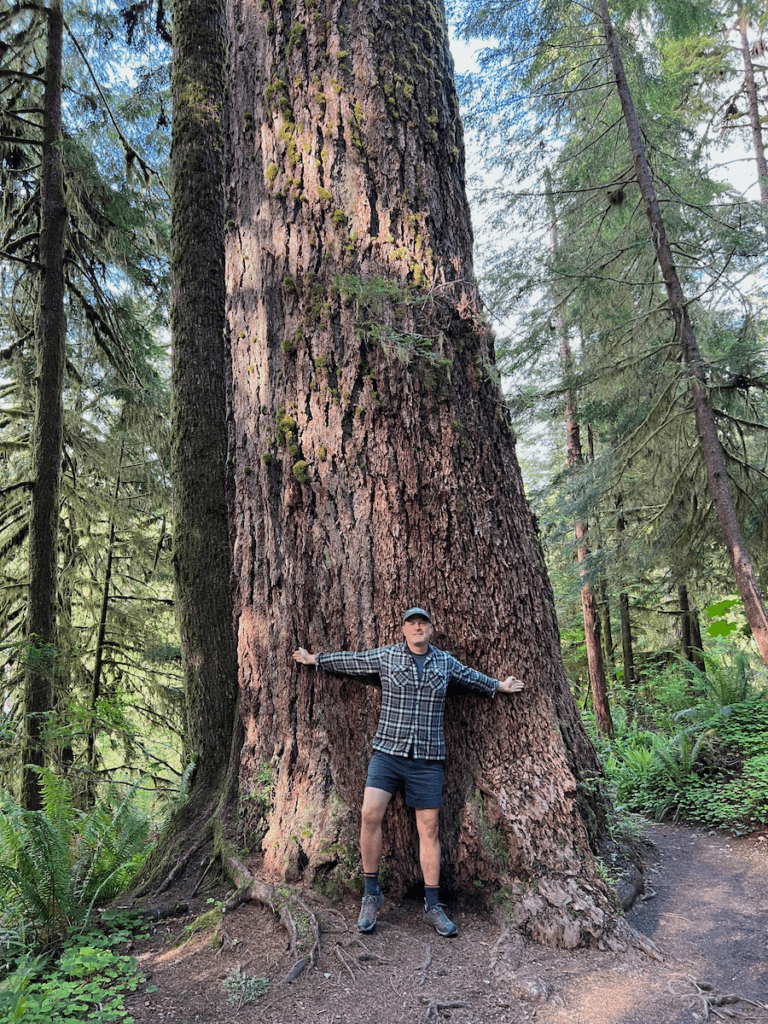
Old-growth forest and mossy delights
While most of the ancient giants were razed for profits a hundred years ago, patches of majestic cedar, hemlock, Douglas fir, and Sitka spruce remain in areas protected by the creation of the Olympic National Park in 1933.
Quinault Lake Loop Trail
My favorite place to take in the power of such giants is Quinault Lake Loop Trail, which begins at Lake Quinault Lodge. This is the best time investment to see a historic lodge, a glacial lake, babbling creeks, hillside waterfalls, and the giant beauties in the mist. Allow 3 hours to take in all the wonder of this magic trail.
Other trails in this area (ask the front desk at the Lodge) rival Hoh Valley Rainforest — without the crowds and additional time investment.
Since Lake Quinault is on the opposite end of the Olympic Peninsula from Seattle and the other popular attractions of Olympic National Park, it might be time-prohibitive to venture this far. If so, the next favorite is the hike to Marymere Falls, on the edge of Lake Crescent.
Marymere Falls
The trail is flat until the end, with a hike up about 100 vertical feet providing fantastic waterfall views. While the waterfall is very busy in Summer and on weekends, the portion between Lake Crescent Lodge and the mid-trail is lesser used. Be sure to park in the area around the Lodge. Best in the morning or late afternoon.
Even if you don’t venture to the waterfall, this is an exquisite 1.8-mile roundtrip. Stop along the churning creek and see the filtered light flowing through age-old cedar and fir. And get lost in the endless rows of waist-high sword ferns.
Speaking of waterfalls, there are a number of them on the Olympic Peninsula. My friend Jennie writes about five exquisite examples in an article HERE.
Staircase
A bit more “local” because it’s off the most convenient Olympic Peninsula road trip routing, the Staircase entrance to Olympic National Park is fantastic. This is located southeast of the park — turn off Highway 101 at Hoodsport, WA.
This stop makes sense if you’re completing the entire loop over a few days or coming from Portland or Olympia, WA. The drive is beautiful and opens up to views of Lake Cushman. Find old-growth giants and mossy goodness within a few miles of the parking area near a seasonal ranger station.
Hoh Valley Rainforest
The Hoh Rainforest is world-famous — for a good reason. However, it is only worth the investment if you want to devote time here, meaning hike beyond the close-in trails. In that case, spend an entire morning or afternoon here with a multi-day itinerary.
If there is any possibility you’ll be rushed here (which happens often because of the location), skip it.
Olympic Peninsula Alpine Views
Hurricane Ridge
Hurricane Ridge is an awe-inspiring experience that involves a winding drive along 17 miles of breathtaking scenery — near Port Angeles, WA. It is also a bustling tourist attraction that sometimes requires waiting at the entrance to the Olympic National Park near Port Angeles.
Due to a tragic fire, entrance is limited, so please refer to the Olympic National Park website for up-to-date information—plan for at least three hours up and down, if not more, for hiking. Best to go in the morning.
Do not rush this experience! If you are short on time, skip this because you’ll end up frustrated with crowds and possible road delays. As of this writing (July 2023), the road is usually closed to private vehicles by noon (depending on the day of the week and the weather).
Clallam Transit operates a shuttle from Port Angeles to Hurricane Ridge, which takes 45 minutes in each direction. It runs regardless of the road closing to private vehicles. There are about six trips each day. More information can be found here: Hurricane Ridge Shuttle (clallamtransit.com)
Deer Park
The main difference between Hurricane Ridge and Deer Park (about an hour from Port Angeles toward Seattle) is the narrow gravel road that winds up to the heavens for 18 miles. As such, there are way fewer people. My friend Jennie has an excellent article ready on her website, so access that information HERE.
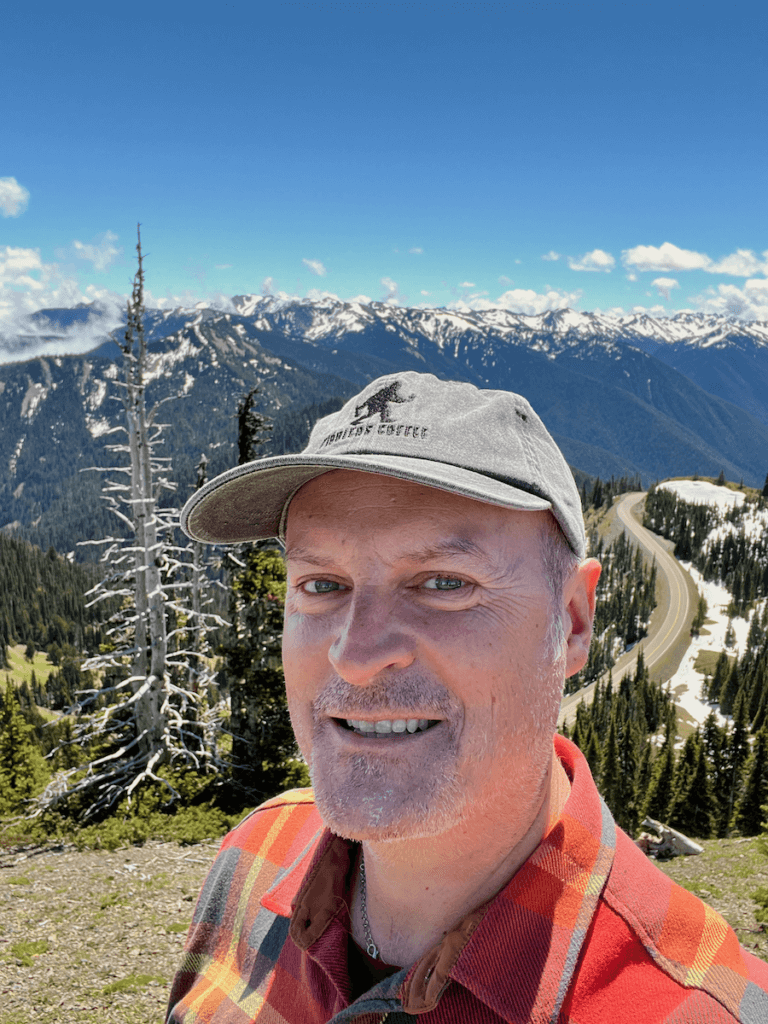
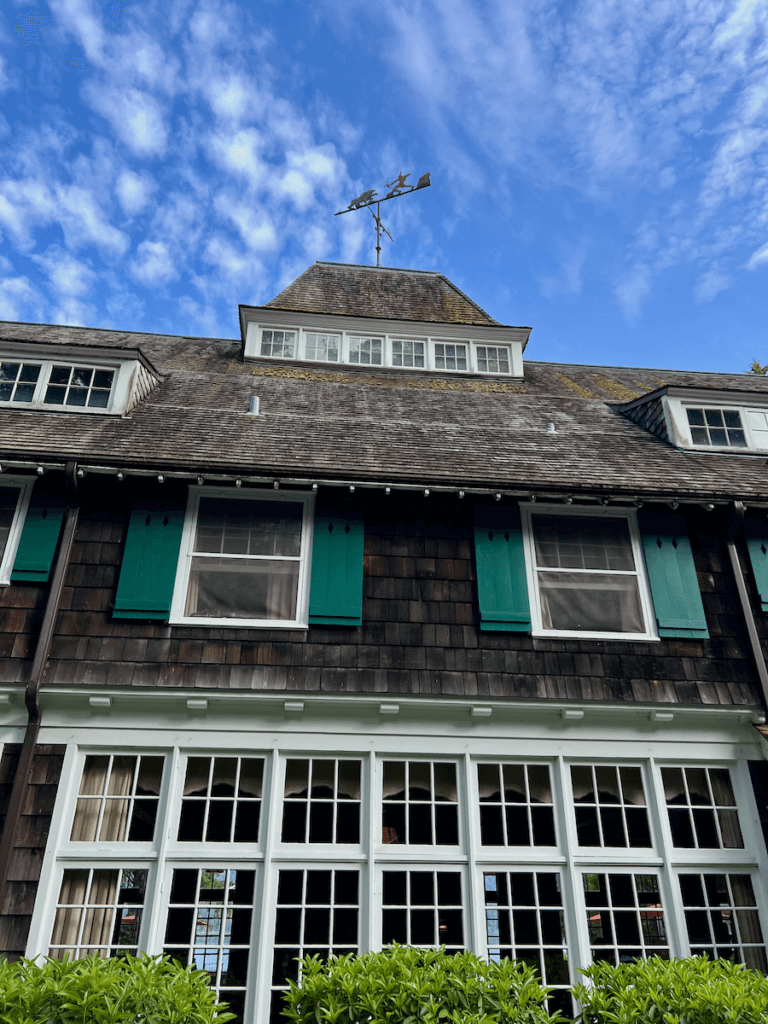
Where to stay on the Olympic Peninsula
Lodging is a little sporadic in the area because so much of the land is a national park, national forest, or tribal land. Outside the Olympic National Park lodges, Port Angeles, WA, and Forks, WA, are the most likely places to find accommodation options. Of the two locations, Port Angeles is easier to reach from Seattle and provides better services.
I like the Red Lion Hotel in Port Angeles, right on the water and within walking distance of the quaint downtown strip of eateries, nightlife, and shops. And, although I have yet to visit this property, the Olympic Lodge by Ayres looks lovely.
Forks, WA, has several mediocre places to stay, but I love Woodland Inns. It’s in the heart of town, across from a decent pizza joint—cozy-themed cabins with new appointments.
Airbnb and VRBO
There are plenty of home shares on the Olympic Peninsula, but be careful. Here are a few of my favorites — excellent in quality and location:
I’ve stayed here before, and it is lovely. The newly renovated property is on a private beach and mere steps from waves washing ashore through the night. The location is also excellent — 30 minutes from the services of Port Angeles and also 30 minutes from Lake Crescent Lodge and the Olympic National Park.
Sol Duc Den-West, A tiny house
This was also a fun place to stop for a night with guests I was guiding from Denmark. This is the article about that three-day road trip. They loved it! Clean, compact, and cozy. It’s very tight, mind you. There are several cabins on the lot. The location near Forks, WA, is a great stop to break up your Olympic Peninsula road trip.
Staying in the Olympic National Park
My favorite places within the Olympic National Park lodging system are Lake Quinault Lodge and Lake Crescent Lodge. Both are in great locations for a road trip itinerary.
Lake Quinault Lodge is the only full-service option in that area of the Olympic Peninsula. Plus, its charm is undeniable. I’ve written an article all about staying here, including information on the different room options. I especially love staying here in the off-season when the rain pours!
Lake Crescent Lodge sells out early, so you’ll need to plan to stay here or else get very lucky. I’ve written about this gem as well. Even if you don’t stay here, it’s close to Highway 101 and makes a fun stop for lunch. Dine in the historic Lodge and walk to the dock for 180-degree views of the stellar lake.
My favorite hotels in the Pacific Northwest
Speaking of Hotels, I have my favorites throughout the Pacific Northwest. You can peruse some hidden gems for this trip or another in the future. They include additional places on the Olympic Peninsula.
Where to eat on the Olympic Peninsula?
I love food, especially eating on road trips. It’s fun to duck into local diners or historic lodges for bites of nourishment along the way. But if you are like me and need regular feedings, plan in this sparsely populated area of Washington State.
Port Angeles and Forks, WA, are the main places for services, including food. Both have full-service grocery stores for provisions and food and beverage options.
Otherwise, the Olympic National Park lodges offer pricey but quality food. I like Kalaloch Lodge and Lake Cresent Lodge for lunch, and Lake Quinault Lodge (photo shown) makes for a lovely dinner. Salmon House is also yummy down the road from Lake Quinault Lodge.
This is the road trip to stock up on provisions at a grocery and enjoy charcuterie-type cuisine on a soulful beach.
Itineraries for Olympic Peninsula road trips
There are many ways to enjoy a road trip in this wild part of Washington State. These are the most popular versions:
- The entire loop starts from Seattle/Tacoma or Portland area.
- Out and back from Seattle/Tacoma area.
- Oregon Coast to Olympic Peninsula long-haul road trip.
- Adding time before and after my nature immersion retreats (which are near Port Angeles, WA).
My itineraries take into account a mindful approach to nature. To read more about my suggestions for nature-forward travel and why it is essential, access a recent article HERE. Please take your time with your road trip to the Olympic Peninsula. There is too much to soak up in the natural wonders.
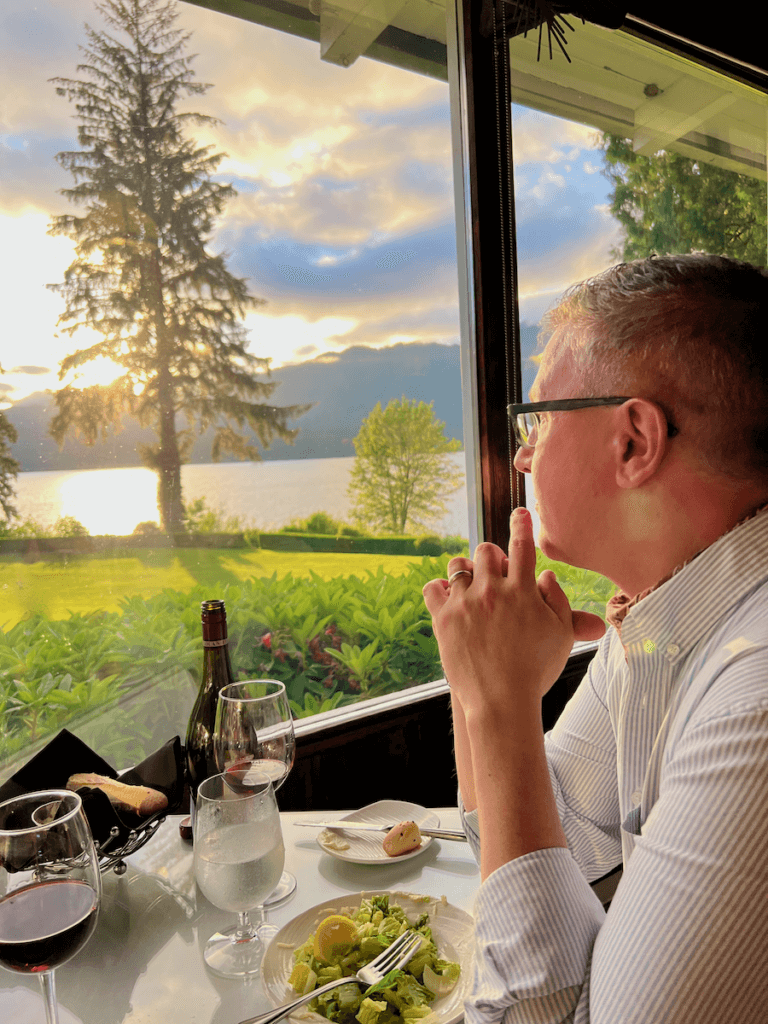

3-day Loop from Seattle/Tacoma or Portland area.
Traffic is better leaving Seattle in the morning, so I suggest driving longer to the Olympic Peninsula on the first day and returning via ferry on the final day.
Day 1: Drive via I5 and 101 to Lake Quinault and stay at the Lodge. Venture onto the Quinault Loop Trail and enjoy dinner at the Lodge or Salmon House.
Day 2: Spend the morning exploring mossy goodness around the lake—late lunch at Kalaloch Lodge. Enjoy a few beach stops, including Ruby Beach, for late afternoon delight. Stay overnight at the Kalaloch Lodge or sleep in Forks at Woodland Inns.
Day 3: Head to Lake Crescent and park at the Lodge. Explore the Marymere Falls trail and eat lunch at the Inn or Port Angeles (Turnip the Beet or New Day Cafe).
Four-day option: Add an extra night at Lake Quinault Lodge and spend more time in this region, which has beaches (Kalaloch), old-growth giants, a lake, mossy trails, historic lodge charm, and fewer visitors. Or, add a night in Port Angeles to arrive at Hurricane Ridge early the following day.
3-day out and back from Seattle/Tacoma area.
This is the “greatest hits” of the northern focus of Olympic National Park. Leave early to enjoy the journey.
Day 1: Ferry from Seattle to Olympic Peninsula and enjoy lunch in Port Angeles. Continue to Lake Crescent Lodge and explore the mossy goodness of the Marymere Falls trail and the peaceful shore of Lake Crescent. Stay at the Lodge, Strait Surf House, or in Port Angeles.
Day 2: Start early and head up to Hurricane Ridge. Enjoy the mist flowing through the valleys and slow down on the trails. Go with a charcuterie lunch or return for a late one in Port Angeles before driving to Sol Duc Hot Springs for a soak (subject to availability) and wander in the forest. Continue to sleep in Forks at Woodland Inns.
Day 3: Head to Second Beach for a short hike and hours-long stroll on the beach. Or Visit Rialto Beach and walk to Hole-in-the-wall. Or both if time allows. Stop in Forks for food and return to Seattle via Port Angeles, WA.
Four-day option: Add an extra night in Forks and spend more time in this region, which allows a trip to Cape Flattery, and Hoh Valley Rainforest for more nature-forward hiking.
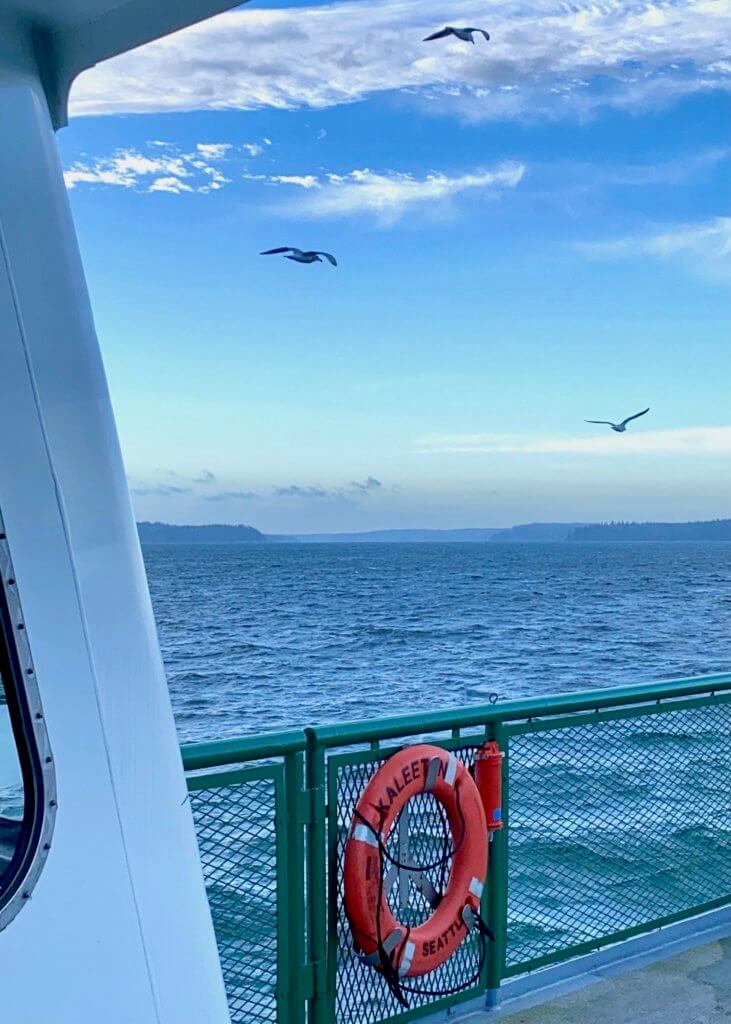

Continue from Oregon Coast (or reverse to Oregon Coast)
I have a lot of information on traveling the Oregon Coast too. Check out a starter article, The Best Oregon Coast Towns to Visit. This routing assumes Day 0 was spent overnighting in Astoria or Seaside, Oregon.
Day 1: Cross the Astoria Bridge and head 90 minutes to Tokeland Hotel for the best food on the Oregon Coast. Continue to Lake Quinault and stay at the Lodge. Venture onto the Quinault Loop Trail and enjoy dinner at the Lodge or Salmon House.
Day 2: Spend the morning exploring mossy goodness around the lake—late lunch at Kalaloch Lodge. Enjoy a few beach stops, including Ruby Beach, for late afternoon delight. Stay overnight at the Kalaloch Lodge or sleep in Forks at Woodland Inns.
Day 3: Head to Lake Crescent and park at the Lodge. Explore the Marymere Falls trail and eat lunch at the Inn or Port Angeles (Turnip the Beet or New Day Cafe).
Four-day option: Add an extra night at Lake Quinault Lodge and spend more time in this region, which has beaches (Kalaloch), old-growth giants, a lake, a variety of mossy trails, historic lodge charm, and fewer visitors. Or, add a night in Port Angeles to arrive at Hurricane Ridge early the following day.
Do you want to enhance your nature immersion retreat with time before and after?
Did you know I facilitate three-day nature immersion retreats on the Olympic Peninsula? If not, access all the details HERE. I can’t wait to work with you if you’re scheduled to attend!
The three-day itinerary includes icons of the Olympic Peninsula, like Lake Crescent, Marymere Falls, and Second Beach. But if you’re interested in some additional experiences, consider this itinerary.
Before the nature immersion retreat:
Day 1: Travel to Lake Quinault and stay at the Lodge. Try to arrive by early afternoon so you can venture onto the Quinault Loop Trail and enjoy dinner at the Lodge or Salmon House.
Day 2: Spend more time (and one more night) in the Lake Quinault region, which has beaches (Klaloch), old-growth giants, a lake, a variety of mossy trails, historic lodge charm, and fewer visitors.
Day 3: Plan three hours to travel from Lake Quinault to Port Angeles, WA, to meet with the retreat group by noon (at Turnip the Beet).
After the nature immersion retreat (days 3, 4, 5):
Day 5: After we say farewell at the retreat (around 1 pm), return to Lake Crescent and Marymere Falls for more time, or continue to Sol Duc Hot Springs (subject to availability) for a soak and gentle hike in the mossy environs. Entrance to the park is required to visit Sol Duc. Overnight in Port Angeles.
Day 6: Start early and head up to Hurricane Ridge. Enjoy the mist flowing through the valleys and slow down on the trails. Go with a charcuterie lunch or return for a late one in Port Angeles before enjoying onward adventures.
If you are flying into Seattle/Tacoma International Airport (SEA), consider this 7-day itinerary:
- Day 1: Arrive in Seattle and continue to Lake Quinault.
- Day 2: Spend the day in the Lake Quinault area.
- Day 3: Continue to meet the group in Port Angeles, WA, for Nature Retreat.
- Day 4: Nature Retreat
- Day 5: Nature Retreat and farewell. Overnight in Port Angeles.
- Day 6: Start early to visit Hurricane Ridge and return to Seattle.
- Day 7: Depart Seattle Airport.
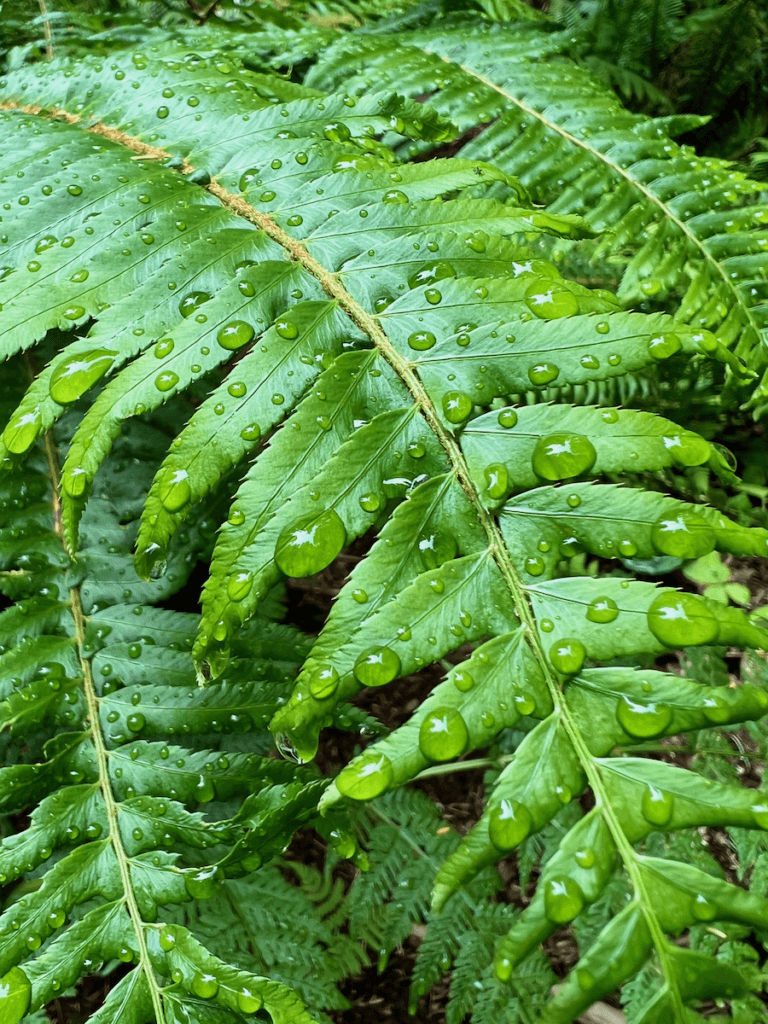
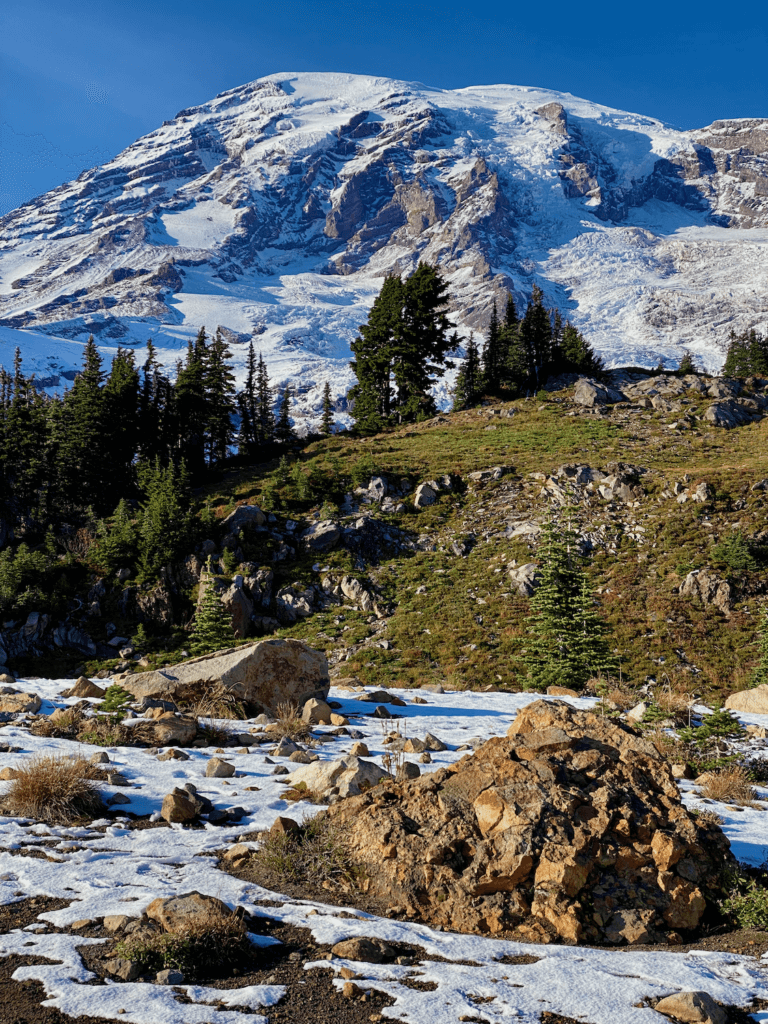
Other Washington State National Parks
The Olympic Peninsula seems to have it all, but Washington State packs some powerful nature splendor into the Cascade Mountain region too. Open your heart to Paradise and the soul-nourishing hiking in that area of Mt. Rainier National Park (photo shown). This can be part of a larger road trip from Seattle to Mt. Rainier, for example. Or, if you’re keen for more rugged and recreational vibe, consider a drive to North Cascades National Park — and onward to Winthrop, WA and points east.
Other add-ons for an Olympic Peninsula road trip.
Although I’ve listed several excellent itineraries above, there are many ways to customize a road trip in the region, including outstanding natural beauty and tasty delights.
Whidbey Island
For example, Whidbey Island offers soulful hiking along coastal estuaries and the most popular Washington State Park — Deception Pass. The island has a distinct “local culture,” I write about my favorite things to do in an article HERE. It includes a great interactive map with all the favorites.
Bainbridge Island
The Kitsap Peninsula is understated while providing Bloedel Reserve, a world-class botanical garden. Look for other natural connections in places like Heronswood Gardens, Point no Point lighthouse, Grand Forest West, and a labyrinth made from local stones and shells. I write about all this in an article HERE.
Port Townsend
Consider an overnight in the historicly charming Port Townsend, WA. 19th-century architecture abounds as the Chicmahan trail offers an immersion into a rich culture that was alive for thousands of years before European contact. Access my list of 23 exciting things to do in Port Townsend.
Tokeland Hotel
Those heading to or from the Oregon Coast are in for a treat at my quirky but favorite Tokeland Hotel on the Washington Coast. It is the oldest running hotel in the State of Washington, with cozy European-style rooms above the best eatery in the entire region. Be sure to tell owners Heather and Zac hello for me!
Other Washington State road trips
I’ve spent a lifetime traversing the Pacific Northwest and have many ideas for road trips that allow time to stop in interesting places to break up driving. My local knowledge is advantageous when going on Interstate State 5 between Vancouver, BC, and Portland, Oregon.
For example, you can drive from Vancouver, Canada, to the Olympic Peninsula. Consider reading this article, Seattle to Vancouver Drive, for all the hints, including a valuable interactive map.
Travel to and from the Olympic Peninsula
The location of this wild part of Washington State makes logistics a bit awkward due to the water surrounding the land mass on three sides. If you’re venturing to the Olympic Peninsula on an airplane or train first, you’ll want to consider the entire excursion. Many international visitors select one city and tour from there. Vancouver, Canada (YVR), and Seattle (SEA) offer the most international nonstop flights in the region.
Getting between Vancouver and Seattle
If traveling between Vancouver and Seattle, you might consider taking the train. I have a very detailed article describing this experience HERE. An article about the driving version with over 20 road trip stops between the two metro areas can be accessed HERE.
Oregon Coast road trip
Other visitors use this opportunity to take a more extended road trip between San Francisco and Seattle (or Vancouver) through the Oregon Coast and Olympic Peninsula. You’ll need at least ten days to do this without rushing. If so, I have many resources about the Oregon Coast.
Travel distances to the Olympic Peninsula
Otherwise, here are a few landmarks to help plan your Olympic Peninsula road trip distances. I’m using Port Angeles as the base since it’s the most major development near the Olympic National Park. These estimated drive times do not account for stopping along the way (you should, of course!)
- Victoria, Canada — 40 Km (2:10 hours on a daily car ferry)
- Seattle area — around three hours (both ferry or driving via Tacoma Narrows Bridge).
- Vancouver, Canada area — typically four to five hours.
- Portland, Oregon area — typically four to five hours.
- Astoria, Oregon Coast — typically four to five hours.
Lake Quinault is on the opposite end of the Olympic Peninsula from Port Angeles, and it takes about 2:30 hours to drive between the two without stopping. These are estimated drive times:
- Olympic, WA — 1:45 hours.
- Seattle area — two to four hours (go in the morning!)
- Astoria, Oregon Coast — 2:30 to three hours.
- Portland, Oregon area — three to four hours.
- Vancouver, Canada area — five to six hours.

